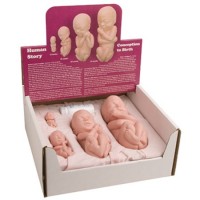LUTHERANS FOR LIFE of IOWA
What Science Reveals About Fetal Pain
by Arina Grossu of FRC
Family Research Council's (FRC) Center for Human Dignity has published "What Science Reveals about Fetal Pain," an updated analysis paper presenting more than 30 scientific studies, testimonies, medical evidence, and real life experiences that demonstrate that an unborn child can feel pain by 20 weeks post-fertilization.
Visit frc.org/fetalpain to read the full analysis:[1]
- Late abortion is excruciatingly painful for the unborn child, regardless of the method, and it should not be legally sanctioned.
- The state has a compelling interest in protecting the lives of unborn children from the stage at which substantial medical evidence indicates that these children are able to feel pain.
- Passage of the Pain-Capable Unborn Child Protection Act would protect the almost 13,000 pain-capable unborn children who die from late abortion each year in the U.S.
- The overwhelming majority of Americans agree on setting abortion bans for pain-capable children. Quinnipiac asked voters in Nov. 2014 if they supported the Pain-Capable Unborn Child Protection Act as passed by the House in 2013; 60% said they supported the bill.
- The bill punishes abortionists who knowingly perform an abortion after 20 weeks post-fertilization with up to five years in jail; it explicitly protects a woman who has an abortion from any prosecution.
Science shows early pain-capability of babies:
- By 18 weeks post-fertilization, nerves link pain receptors to the brain's thalamus (the pain processing center).
- By 18 weeks post-fertilization, all of the neurons are present in the cerebral cortex (the region of the brain associated with higher mental functions), even though not all the connections in the cortex are fully developed until later.
- By as early as 16 weeks post-fertilization, painful stimuli have been shown to elicit stress responses in unborn children.
- Pain is sensed more acutely by babies 20-30 weeks post-fertilization than by newborns and even by adults because the pain receptors are present and close to the surface of the skin, but the mechanisms that inhibit pain do not develop until 32-34 weeks post-fertilization.
Common use of fetal anesthesia:
The administration of pediatric anesthesia during fetal surgeries has become routine in recognition of the pain felt by unborn babies. When administered, anesthesia decreases stress hormones in the unborn child when compared to their level when painful stimuli are applied without anesthesia.
The unborn child as a patient:
The unborn child is medically considered a patient in cases where a parent wants to preserve the child's life. As a result, he or she is given fetal anesthesia before an in-utero surgery.
A functioning cerebral cortex is not necessary to feel pain, only the thalamus:
A functioning cerebral cortex is not necessary in order for the unborn child to feel pain, as evidenced by scientific studies and observations that both children and adults who are born with no or minimal cerebral cortex, in fact, do still perceive pain.
Fetal structures of pain perception differ from adult structures:
The unborn child's ability to feel pain depends on complex pain processing mechanisms and neural pathways, structures that change with each stage of development.
Technology reveals the humanity of the baby:
4D Ultrasounds show us the humanity of the child and studies have been done that capture facial expressions in unborn children including expressions of pain.



